Heating fireplaces. heating scheme. varieties of devices
Some owners of country houses instead of utilitarian and not very aesthetic boiler, heating the coolant, prefer alternative methods of heating. The increasing popularity is gained by a fireplace for heating of the house.
In addition to the comfort created by an open flame, these devices can quite effectively heat the air for the duct system or water for radiators. Instructions for arranging such a climate network are given below.
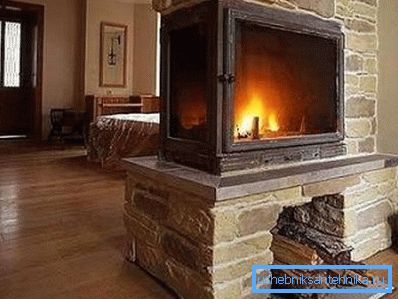
General heating scheme
Despite the huge number of different climatic equipment, fireplaces for home heating do not lose their popularity. Moreover, thanks to technical improvements, such a design has become not only an exclusive element of the room design, but also an effective way to heat all the premises of a dwelling.
The heating fireplace can raise the air temperature not only in the room where it is installed, but also in the neighboring ones (even if the house has an attic or a second floor).
To solve this problem, use units that allow you to organize:
- air heating - heated air through specially equipped air ducts gets into other rooms;
- water heating - open fire heats the coolant in a special tank or coil, after which the liquid is transported through pipes to the radiators of the heating (as with the classical heating scheme).

Note! If you plan to install a stove in the upper part of the fireplace, it can even be used for cooking. Do not forget in this case to take care of high-quality ventilation, otherwise the smell of fried fish or meat will spread throughout the house.
Let us dwell in more detail on which fireplaces for heating are currently used.
Varieties of devices
With open firebox
Discussing heating and fireplaces, it is advisable to start with the classic options - designs with an open hearth. They have long served as a source of heat, but now the lack of such a solution is obvious: the device will not be able to heat even an average area of the room, not to mention the neighboring ones.
This is due to extremely low efficiency. Arranging home heating by a fireplace with an open hearth, one should be prepared for the fact that more than 80% of the heat energy evaporates into the chimney and only 20% is used for heating.
In addition, maintaining a flame in open fireplaces will require twice as much fuel (the price is high enough) than for heaters with a closed firebox. Also in the room where the unit is installed, it is necessary to ensure the flow of the required amount of fresh air, which is involved in the combustion process.
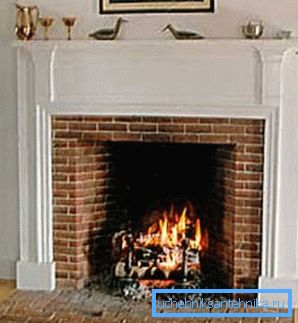
Do not forget about the rules of fire safety.
The relevant instruction reads as follows:
- You can not leave the outstanding flame in the furnace for a long time (at night or during the absence of the owners in the house).
- The flooring near the heating device must be covered with a non-combustible material (especially if wood-burning fireplaces are used for heating, of which smoldering ash may fall out if handled carelessly).
With closed firebox
Such fireplaces for home heating have some advantages:
- High efficiency. More than three quarters of the thermal energy generated by the combustion of fuel is used effectively.
- Can be used as an additional or backup heat source in the house.
- Furnace chambers are made of high-strength material with high thermal inertia. They perfectly withstand strong temperature fluctuations, resist corrosion and persistently warm the room after the end of the process of burning wood.
- Outside, the combustion chamber is protected by heat-resistant glass that can withstand heat up to + 800 degrees Celsius. It is mounted so that it is convenient to load fuel into the fireplace.
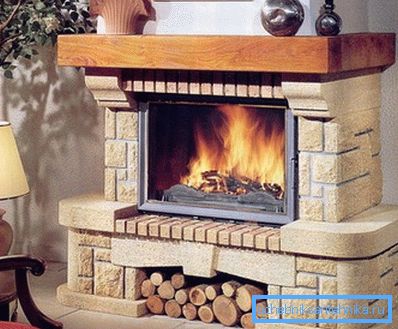
Note! Fireplace heating at home should provide for the production of about 1 kW of thermal power per 4 m 2 of space. In addition, the area of the room where the heater is installed must be at least 45 m 2.
Considering that oxygen is necessary to maintain the fire, it is necessary to equip productive ventilation in the room. The volume of inflow is calculated as follows: for generating 1 kW of heat, 10 m3 of air is needed
That is, if the fireplace generates 5 kW of heat, the duct with a fan should provide 50 m3 intake.
The great advantage of the considered structures with a closed firebox is that when installing additional equipment they are able to heat the air not only in the room where they are installed, but also in the neighboring rooms. And you can build everything with your own hands, without attracting expensive specialists.
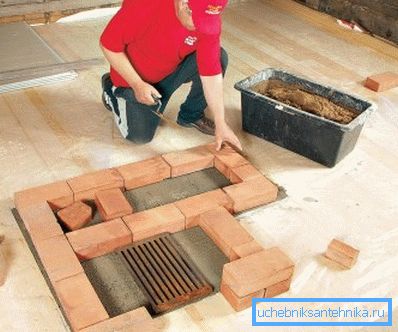
Heating design with a fireplace
Before you heat the house with a fireplace, you should carefully understand the principles of operation and design features of the classic version of the described unit.
So, what is the usual fireplace:
- The main element is the firebox, above it there is a chimney through which combustion products harmful to humans are removed. The area of its cross-section should be at least 10% of the area of the combustion chamber. In this case, the classic galvanized chimney should be connected to the smoke exhaust channel of the fireplace at a distance of at least 5 meters.
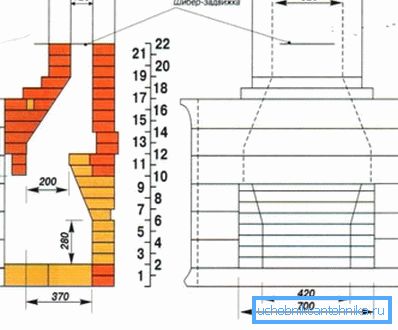
- The place of the joint between the pipe and the chamber itself, where the combustion of firewood takes place, is equipped with a sliding or hinged gate. It will help keep the accumulated heat and will be useful when cleaning the outflow channels from the carbon deposited there.
- When building a house, it is important to provide an additional foundation for the installation of the unit, since the average weight of the structure is about half a ton. If you go to arrange a fireplace heating of a country house that has already been built, take care to strengthen the individual structural elements of the latter.
Heating of adjacent rooms is carried out according to two main schemes:
- heated circulating air;
- with heating the heat-transfer fluid, which is then distributed to the radiators.

Air fireplace heating
In this case, the fireplace is designed and built so that there is room for air circulation between the steel or cast-iron firebox and the outer surface of the heater. The latter, when heated, is distributed to other rooms of the house by means of specially installed and interconnected air ducts.
They can be mounted as closed (in the walls or in the attic), and in the open way. The material will be pipes made of galvanized steel or aluminum.
Circulation of air masses can be organized:
- In a natural way. In this case, the movement of air is provided by the difference in its temperature and density. The advantage is complete non-volatility of the heating system. The disadvantage is low productivity and the inability to organize, thus, heating a large area structure.
- Forcibly. In this case, use a variety of fans and turbines that run on electricity. Remember that the air will still circulate in a closed circuit, since the fence of street air masses in the winter is undesirable because of their low temperature.
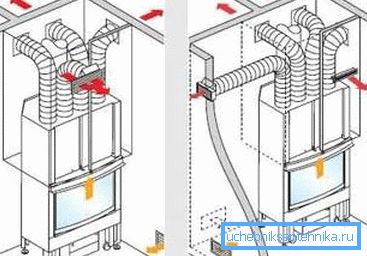
Note! If the area of the rooms is large, or the length of the air ducts exceeds 3 meters, or the house has many separate rooms, it is necessary to use only heating with forced ventilation.
Typically, such a heating scheme is designed and constructed during the construction of the house. Otherwise, it will be very problematic to make air ducts and aesthetically pleasing them in rooms.
The heating network described above is quite effective. It can even heat up spacious country villas. Another plus is the absence of coolant, which, after stopping the heat supply, could freeze.
Water fireplace heating
The furnace of this unit consists of two layers, between which the heat-transfer fluid circulates. Subsequently, water or antifreeze is delivered via pipelines to the radiators, where the heat exchange between water and air in the room takes place.
The advantage of this system is that it is able to provide the residents of the cottage not only with heat, but also with hot water for domestic needs. To do this, you need to install in the upper part of the heater a special container of the required volume or a coil with forced circulation.
Equipment power control can also be done in different ways:
- manually - by increasing or decreasing the air flow entering the furnace (for this purpose, special valves are used);
- automatically - here thermostats come into operation, on which the intensity of the pumps pumping the coolant depends.
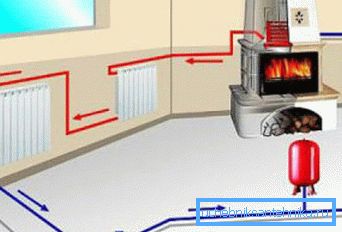
When deciding on the use of a fireplace with a water circuit as the main source of heat, you need to remember the following nuances:
- The fireplace quickly warms up the rooms in the house, but also cools quickly after the fire goes out. Therefore, it is better to use it for heating cottages and cottages that are not intended for year-round living (in this case, take care to fill the pipes with not antifreeze, not water, but antifreeze).
- The pipelines through which the coolant flows must be no more than 10–15 mm in diameter, otherwise you will encounter large heat losses.
Pros and cons of fireplace heating
The positive aspects of the use of fireplaces as the main source of heat include:
- the speed of heating the premises of the house (it takes much less time than using a traditional boiler with a heat-transfer fluid);
- full non-volatility (with the exception of systems with forced air circulation and heat transfer fluid - in this case, the pumps will need electricity);
- no need to allocate a separate room for the installation of the boiler;

- affordable equipment cost;
- esthetic qualities - the fireplace not only warms, but also effectively decorates the room;
- the opportunity not only to heat the house-building, but also to have hot water, as well as to cook food on a specially installed stove.
The disadvantages include the need to store a large supply of firewood, as well as the difficulty of cleaning the combustion chamber from ash.
Features of the design of fireplaces
Regardless of whether you design the fireplace yourself or have entrusted this responsible work to a professional, you must make sure that during its construction the following rules are observed:
- The fireplace should be mounted on a solid foundation, made of reinforced concrete, brick or cinder block.
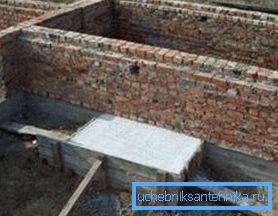
- The installation of the circuit for heating air or water is done after the fire chamber is firmly fixed.
- Air ducts for space heating should be placed in all rooms (even in the attic or attic). To make pipes look more aesthetically pleasing, they can be disguised with plasterboard sheets. Do not forget to take measures for thermal insulation and fire protection.
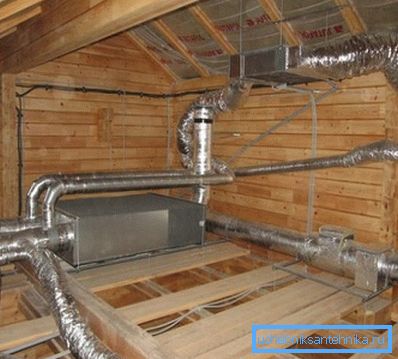
- The main node of the air system with forced circulation is desirable to place in the back room, since the noise from operating fans can cause inconvenience and cause discomfort.
Security measures in the operation of fireplaces
In order to avoid injuries, burns and fires, when using fireplace heaters, you should follow these rules:
- you can not cook food directly in the furnace or in any other way use it for other than its intended purpose;
- Do not fill the burning fuel with water, as this may cause cracks in the combustion chamber;
- do not place extraneous things on the surfaces of the fireplace, especially those that may ignite under the action of high temperature;
- do not clean the combustion chamber and the ashpit from the remnants of unburned fuel until the unit is completely cooled;
- do not use the fireplace when it detects a malfunction of the combustion chamber;
- young children should not be left near a working or hot fireplace without adult supervision.

Conclusion
Fireplaces - one of the oldest ways to heat a home. However, using additional equipment built into them, you can provide comfort and warmth throughout the house.
The main thing is to correctly perform all engineering calculations and construction work. You can learn more about this from the video below. And if you have any questions - ask them in the comments, we will be happy to help you with the problem.